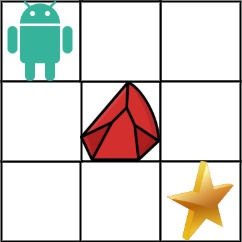63. Unique Paths II
Description
You are given an m x n integer array grid. There is a robot initially located at the top-left corner (i.e., grid[0][0]). The robot tries to move to the bottom-right corner (i.e., grid[m - 1][n - 1]). The robot can only move either down or right at any point in time.
An obstacle and space are marked as 1 or 0 respectively in grid. A path that the robot takes cannot include any square that is an obstacle.
Return the number of possible unique paths that the robot can take to reach the bottom-right corner.
The testcases are generated so that the answer will be less than or equal to 2 * 10^9.
Example 1:

1 | Input: obstacleGrid = [[0,0,0],[0,1,0],[0,0,0]] |
Example 2:

1 | Input: obstacleGrid = [[0,1],[0,0]] |
Constraints:
m == obstacleGrid.lengthn == obstacleGrid[i].length1 <= m, n <= 100obstacleGrid[i][j]is0or1.
Hints/Notes
- 2025/04/03 Q3
- dp
- Leetcode solution
Solution
Language: C++
1 | class Solution { |